 Nate Paradiso created this composite image of the lunar eclipse on Tuesday, April 15, as seen from the foothills of Boulder, Colorado.
Nate Paradiso created this composite image of the lunar eclipse on Tuesday, April 15, as seen from the foothills of Boulder, Colorado.  CNN iReporter Dan Huntley mostly does landscape and travel photography, but he turned his camera to the sky for this shot of the "blood moon" over Dallas. Huntley has seen eclipses before but not a blood moon. He described it as being "quite amazing."
CNN iReporter Dan Huntley mostly does landscape and travel photography, but he turned his camera to the sky for this shot of the "blood moon" over Dallas. Huntley has seen eclipses before but not a blood moon. He described it as being "quite amazing." Photographer José Dominguez Barrera caught one couple's romantic moment in Chetumal, Mexico, under Tuesday's blood moon. The man got down on one knee and proposing to his girlfriend. The photographer didn't know the couple, but he found the moment an emotional one.  iReporter Heith Pino of St. Helena, California, used an intervalometer and a shutter release to capture a photo of the blood moon every four minutes. He stitched together six shots to create this time-lapse photo series. "I was blown away by the colors it reflected and knew I had to brave the cold, chilly evening to capture it," Pino said.
iReporter Heith Pino of St. Helena, California, used an intervalometer and a shutter release to capture a photo of the blood moon every four minutes. He stitched together six shots to create this time-lapse photo series. "I was blown away by the colors it reflected and knew I had to brave the cold, chilly evening to capture it," Pino said.  Jeffrey Root shot this photo of the April 15 blood moon through a telescope in Salt Lake City.
Jeffrey Root shot this photo of the April 15 blood moon through a telescope in Salt Lake City.  High school sophomore Ahan Malhotra and his dad captured this composite image of the blood moon over Miami early April 15. "My dad and I have been planning to view this for many months, and it was truly a breathtaking experience," said Malhotra, an astronomy enthusiast who likes to photograph "mostly galaxies and nebulae."
High school sophomore Ahan Malhotra and his dad captured this composite image of the blood moon over Miami early April 15. "My dad and I have been planning to view this for many months, and it was truly a breathtaking experience," said Malhotra, an astronomy enthusiast who likes to photograph "mostly galaxies and nebulae."  The April 15 blood moon passes over Port Orange, Florida, in this time-lapse image from Kenneth Ngyuwai.
The April 15 blood moon passes over Port Orange, Florida, in this time-lapse image from Kenneth Ngyuwai.  Photographer Tiffany Chee-Stalnaker captured this radiant shot in Plano, Texas, early Tuesday. She says she's always up at night and this time, the sight was "beautiful."
Photographer Tiffany Chee-Stalnaker captured this radiant shot in Plano, Texas, early Tuesday. She says she's always up at night and this time, the sight was "beautiful."  Robert Ondrovic drove around for 90 minutes -- and 70 miles across the New York City suburbs -- before he found a clear patch of sky. Ondrovic used his mobile Wi-Fi to live stream Doppler radar images to his laptop, where he created this composite image. "One of my tougher moon shots to say the least," he said.
Robert Ondrovic drove around for 90 minutes -- and 70 miles across the New York City suburbs -- before he found a clear patch of sky. Ondrovic used his mobile Wi-Fi to live stream Doppler radar images to his laptop, where he created this composite image. "One of my tougher moon shots to say the least," he said.  Kevin Cavallin snapped this photo in Ames, Iowa, at 2:45 a.m. local time. He captured it without a telescope, which was a challenge. "As expected, had a difficult time getting the exposure without bad motion blur," said Cavallin, a laboratory technologist who enjoys photographing wildlife.
Kevin Cavallin snapped this photo in Ames, Iowa, at 2:45 a.m. local time. He captured it without a telescope, which was a challenge. "As expected, had a difficult time getting the exposure without bad motion blur," said Cavallin, a laboratory technologist who enjoys photographing wildlife.  Dan Medina attached his camera to his telescope to capture this lunar image in Myakka City, Florida. "I stayed up until about 4 a.m. watching the moon. It was worth it," he said.
Dan Medina attached his camera to his telescope to capture this lunar image in Myakka City, Florida. "I stayed up until about 4 a.m. watching the moon. It was worth it," he said.  Fourteen-year-old Will Schweizsr and his father woke up at 2 a.m. in Dallas, Texas, to catch the eclipse. "It was amazing! It made the perfect triangle in the sky with the star Spica to its bottom right and Mars above it," he said.
Fourteen-year-old Will Schweizsr and his father woke up at 2 a.m. in Dallas, Texas, to catch the eclipse. "It was amazing! It made the perfect triangle in the sky with the star Spica to its bottom right and Mars above it," he said.  No stranger to astronomical photography, J. David Osorio photographed the different phases of the lunar eclipse. He started photographing at 10:45 p.m. Monday and stopped at 3 a.m. Tuesday. See more of his photos of the moon's progression.
No stranger to astronomical photography, J. David Osorio photographed the different phases of the lunar eclipse. He started photographing at 10:45 p.m. Monday and stopped at 3 a.m. Tuesday. See more of his photos of the moon's progression. 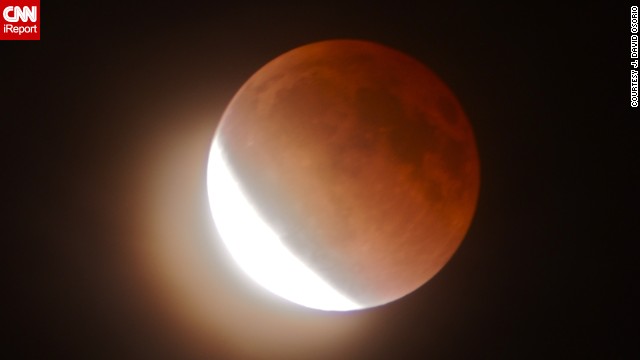 Osorio was part of a small group of past and present physics students from California State University Northridge that got together to view Tuesday's lunar eclipse and blood moon. "The meeting was spontaneous," said Osorio, an alumnus.
Osorio was part of a small group of past and present physics students from California State University Northridge that got together to view Tuesday's lunar eclipse and blood moon. "The meeting was spontaneous," said Osorio, an alumnus.  Osorio joined students and alumni for the photography session on top of a parking structure at the school. Using telescopes, they were able to capture some clean images before the sky clouded over.
Osorio joined students and alumni for the photography session on top of a parking structure at the school. Using telescopes, they were able to capture some clean images before the sky clouded over. 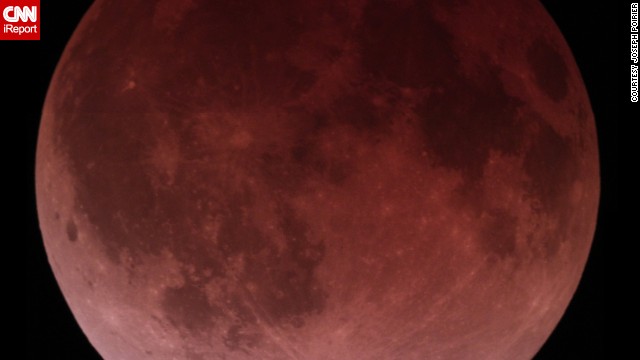 Joseph Poirier shot this photo of the blood moon in Austin, Texas, with his telescope. He says he woke up his 10-year-old son, who had never seen a lunar eclipse before.
Joseph Poirier shot this photo of the blood moon in Austin, Texas, with his telescope. He says he woke up his 10-year-old son, who had never seen a lunar eclipse before.  "It was a very cold 25-degree night but very peaceful outside. No wind, only coyotes howling in the distance," said Cheryl Lippold, who got out of bed at 4 a.m. to see the eclipse over Hiawatha, Kansas. "I am glad I set my alarm so I could get up and watch it."
"It was a very cold 25-degree night but very peaceful outside. No wind, only coyotes howling in the distance," said Cheryl Lippold, who got out of bed at 4 a.m. to see the eclipse over Hiawatha, Kansas. "I am glad I set my alarm so I could get up and watch it."  Norm Keally stood outside in 28-degree weather to capture the start of the lunar eclipse in Fort Collins, Colorado, early Tuesday. "I felt fortunate to be able to witness this eclipse," he said.
Norm Keally stood outside in 28-degree weather to capture the start of the lunar eclipse in Fort Collins, Colorado, early Tuesday. "I felt fortunate to be able to witness this eclipse," he said.  Dan Hiris said that getting this photo "required a few hit or miss shots," but luckily he had a few hours to get it right. "It felt like the entire solar system turned red," he said.
Dan Hiris said that getting this photo "required a few hit or miss shots," but luckily he had a few hours to get it right. "It felt like the entire solar system turned red," he said.  Kyle Hansen stood outside for an hour in 25-degree weather to get this shot of the blood moon over Burnsville, Minnesota. He said it was "very cool to see the shadow of the earth on the moon." Click the double arrow to see more photos.
Kyle Hansen stood outside for an hour in 25-degree weather to get this shot of the blood moon over Burnsville, Minnesota. He said it was "very cool to see the shadow of the earth on the moon." Click the double arrow to see more photos. 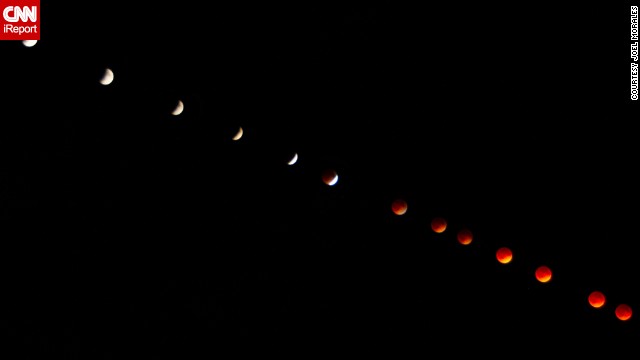 Joel Morales says he superimposed 100 separate images to create this progression photo of the blood moon over Dundedin, Florida.
Joel Morales says he superimposed 100 separate images to create this progression photo of the blood moon over Dundedin, Florida.  "It was about an eighth lit up, then about 15 minutes later it started to turn this beautiful red, almost as if Mars or Mercury were very close, close enough for the naked eye" to see, said Robert Aycock of the eclipse over Temecula, California.
"It was about an eighth lit up, then about 15 minutes later it started to turn this beautiful red, almost as if Mars or Mercury were very close, close enough for the naked eye" to see, said Robert Aycock of the eclipse over Temecula, California. 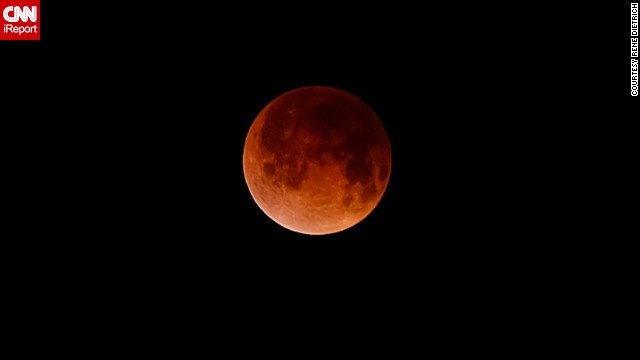 René Dietrich says he was up until 3 a.m. to capture this photo from his back yard in San Juna, Puerto Rico, and had to be back up at 7 a.m. to get to work at his dental practice. He says it was worth losing sleep to "see this spectacular show nature offers to us, completely free!"
René Dietrich says he was up until 3 a.m. to capture this photo from his back yard in San Juna, Puerto Rico, and had to be back up at 7 a.m. to get to work at his dental practice. He says it was worth losing sleep to "see this spectacular show nature offers to us, completely free!"  Abe Blair says it was cloudy when he got up to take pictures of the blood moon, but he decided to try anyway. "I am glad I trusted my gut feeling," he said. Blair had picked this tree out earlier in the day, but he had to hike for about 15 minutes in the dark to get there. He says he shot a two-second exposure for the moon and a 20-second exposure of the tree, and then combined the images in Photoshop.
Abe Blair says it was cloudy when he got up to take pictures of the blood moon, but he decided to try anyway. "I am glad I trusted my gut feeling," he said. Blair had picked this tree out earlier in the day, but he had to hike for about 15 minutes in the dark to get there. He says he shot a two-second exposure for the moon and a 20-second exposure of the tree, and then combined the images in Photoshop.  Jamal Green used Photoshop to create this composite of shots of the moon over Los Angeles at different phases of Tuesday's eclipse. At the height of the eclipse, "the moon looked like a muted sunset in the night sky," he said.
Jamal Green used Photoshop to create this composite of shots of the moon over Los Angeles at different phases of Tuesday's eclipse. At the height of the eclipse, "the moon looked like a muted sunset in the night sky," he said.  Christopher Decker put his cell phone camera up to a 10-inch telescope to capture these images of the blood moon over Sargent, Nebraska. He says the final product, a composite of 10 images, was "absolutely worth every minute."
Christopher Decker put his cell phone camera up to a 10-inch telescope to capture these images of the blood moon over Sargent, Nebraska. He says the final product, a composite of 10 images, was "absolutely worth every minute." 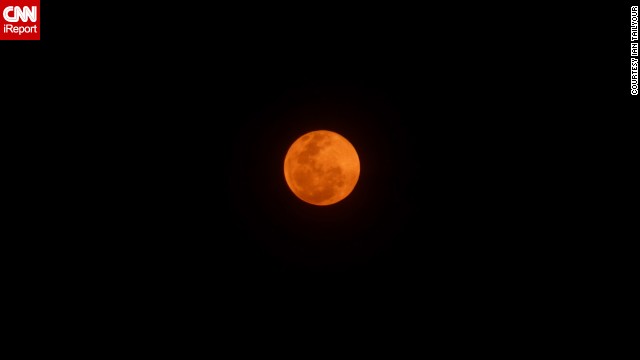 Ian Tailyour took this photo of the blood moon from the 22nd floor of his apartment in Ho Chi Mihn City, Vietnam.
Ian Tailyour took this photo of the blood moon from the 22nd floor of his apartment in Ho Chi Mihn City, Vietnam.  Jason Asselin of East Kingsford, Michigan, says he nearly missed the total lunar eclipse. "I had fallen asleep on the couch and woke up just as the full eclipse had started," he said.
Jason Asselin of East Kingsford, Michigan, says he nearly missed the total lunar eclipse. "I had fallen asleep on the couch and woke up just as the full eclipse had started," he said.
- A lunar eclipse will turn the moon a burnt reddish orange
- This blood moon will be the size of a super moon, 5.3% larger than the last blood moon
- It will be the second in a sequence of four -- called a tetrad
- Tetrads can be rare; for a 300-year stretch, there were none
We want to see your shots of the blood moon! Share your best photos with iReport, and you could be featured on CNN.
(CNN) -- Blood moon, Act II, opens soon in the heavens near you. And it will be bigger than Act I.
If you live in the western half of the United States, you'll have a front-row seat on a lunar eclipse that will turn the moon a burnt reddish orange for about an hour Wednesday, creating the second blood moon in relatively short succession.
The full eclipse will start at 6:25 a.m. ET, NASA says, and last until 7:24 a.m. ET.
Because it happens right after the perigee, the closest point to Earth in the moon's orbit, this blood moon will be nearly the size of a super moon -- appearing 5.3% larger than the previous blood moon on April 15.
 Lunar eclipse in a minute
Lunar eclipse in a minute It will be the second in a sequence of four -- called a tetrad -- that are occurring in roughly six-month intervals. The next one will appear on April 4, 2015, and the last one on September 28, 2015.
Tetrad a rare treat
With that frequency, one might be misled into thinking that blood moons are commonplace.
There are about two lunar eclipses per year, NASA says. Some of them -- penumbral eclipses -- are so subtle, they are vaguely visible and go greatly unnoticed.
Other eclipses just cast a partial shadow on the moon but lend it none of that blood moon color that only total eclipses do. And they come around, on average, less than once a year.
The brilliant hue comes from the edges of the sun peeking out around the periphery of the Earth through its atmosphere in a global sunset shining on the moon, which has to be in just the right position to catch those rays.
Lunar eclipses -- penumbral, partial or total -- occur in random order, NASA says. Getting four total eclipses in a row is like drawing a rare lunar poker hand of four of a kind.
"The most unique thing about the 2014-2015 tetrad is that all of them are visible for all or parts of the U.S.A.," said NASA eclipse expert Fred Espenak.

 A "blood moon" rises over the El Salvador del Mundo monument in San Salvador early Tuesday, April 15, as a total lunar eclipse attracts sky gazers across the Americas. In a total lunar eclipse, the full moon turns a coppery red as it passes into Earth's shadow. "It's like seeing all the sunsets on Earth projected on the moon at once," says Indra Petersons of CNN's "New Day."
A "blood moon" rises over the El Salvador del Mundo monument in San Salvador early Tuesday, April 15, as a total lunar eclipse attracts sky gazers across the Americas. In a total lunar eclipse, the full moon turns a coppery red as it passes into Earth's shadow. "It's like seeing all the sunsets on Earth projected on the moon at once," says Indra Petersons of CNN's "New Day." 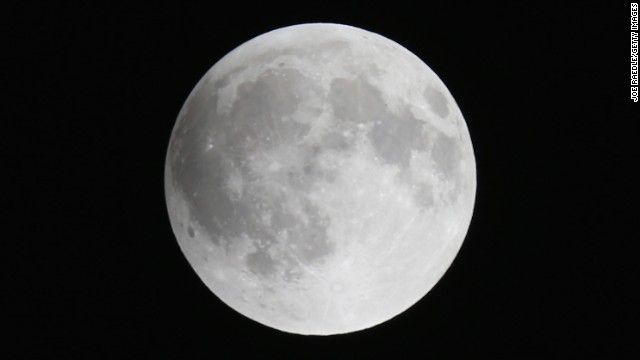 The moon is seen from Miami before the beginning of the total lunar eclipse. The blood moon was most prominent in North and South America.
The moon is seen from Miami before the beginning of the total lunar eclipse. The blood moon was most prominent in North and South America.  Another shot from Miami. Showers and clouds rendered viewing the blood moon a bust in some U.S. cities.
Another shot from Miami. Showers and clouds rendered viewing the blood moon a bust in some U.S. cities.  Dust and sulfur dioxide in the Earth's atmosphere can affect the size of the shadow spreading across the moon's surface.
Dust and sulfur dioxide in the Earth's atmosphere can affect the size of the shadow spreading across the moon's surface.  The moon has to be full for the total lunar eclipse to occur.
The moon has to be full for the total lunar eclipse to occur.  The Earth's shadow crosses over the last bit of reflected light on the moon's surface.
The Earth's shadow crosses over the last bit of reflected light on the moon's surface.  The moon begins to take on a reddish hue early Tuesday from Miami. The moon did so as it appeared in different phases between 2 and 4:30 a.m. ET.
The moon begins to take on a reddish hue early Tuesday from Miami. The moon did so as it appeared in different phases between 2 and 4:30 a.m. ET.  The red hue is caused by refracted sunlight in the Earth's atmosphere, which bounces off the moon while in shadow. The entire reddening process takes about an hour.
The red hue is caused by refracted sunlight in the Earth's atmosphere, which bounces off the moon while in shadow. The entire reddening process takes about an hour. 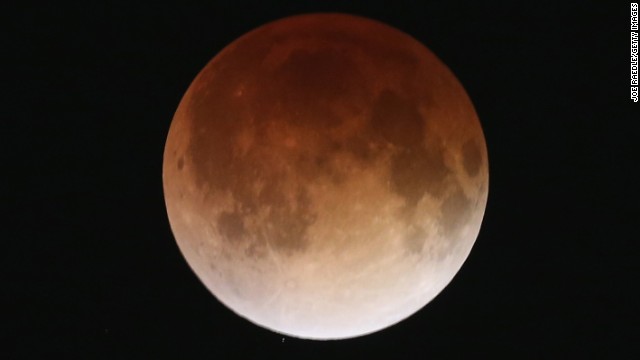 The total lunar eclipse is seen in this image taken from Miami. Unlike solar eclipses, lunar eclipses are safe to view with the naked eye and don't require special filters.
The total lunar eclipse is seen in this image taken from Miami. Unlike solar eclipses, lunar eclipses are safe to view with the naked eye and don't require special filters.  A lunar eclipse takes place over Southern California early Tuesday as seen from the San Gabriel Valley. North America will see a blood moon four times -- known as a tetrad -- between now and September 2015.
A lunar eclipse takes place over Southern California early Tuesday as seen from the San Gabriel Valley. North America will see a blood moon four times -- known as a tetrad -- between now and September 2015. 'Blood moon' sweeps night sky
'Blood moon' sweeps night sky
'Blood moon' sweeps night sky
'Blood moon' sweeps night sky
'Blood moon' sweeps night sky
'Blood moon' sweeps night sky
'Blood moon' sweeps night sky
'Blood moon' sweeps night sky
'Blood moon' sweeps night sky
'Blood moon' sweeps night sky
 Photos: 'Blood moon' sweeps night sky
Photos: 'Blood moon' sweeps night sky People in Europe, Africa and the Middle East, for example, will not be able to see Wednesday's blood moon.
In the 21st century, there will be many such tetrads, but look back a few centuries, and you'll find the opposite phenomenon, NASA says.
Before the dawn of the 20th century, there was a 300-year period when there were none, Espenak says. Zero.
That would mean that neither Sir Isaac Newton, Mozart, Queen Anne, George Washington, Napoleon, Abraham Lincoln nor their contemporaries ever had a chance to see such a sequence.
The stuff of mystics
There are those who like to veil these astral junctures in mysticism, and for them, the epilogue to Wednesday's celestial theatrics could sound like this:
Blood adorned a heavenly plate for Passover fest,
When sun and Earth aligned, a cooper glow to cast,
Upon the face of the moon as it did by Earth pass.
It shall again, to mark another holy rite, alas!
It's common to hang superstitions on blood moons, citing their concurrence with Jewish religious holidays.
The first one in this tetrad fell on Passover; the current one falls on the lesser known holiday of Sukkot, four days after Yom Kippur.
But that's no reason to go loony over cosmic coincidences -- because there are none here.
The Jewish calendar is an ancient lunar one, and holy dates are set, on purpose, to the precise clockwork of the moon's phases.
They're the same predictable ones that make it easy for modern-day astronomers to exactly calculate blood moons.
Planning to photograph the blood moon on October 8? Share your best images with CNN iReport.